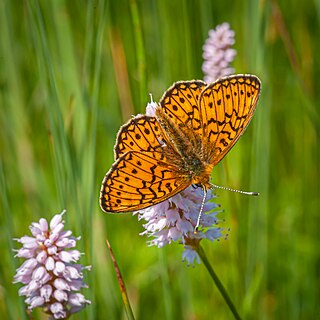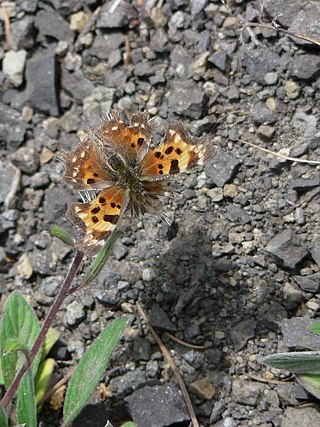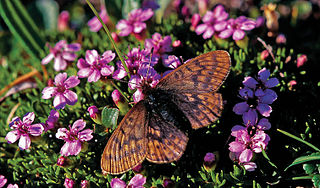
The great spangled fritillary is a North American butterfly of the family Nymphalidae.

The Diana fritillary is a fritillary butterfly found in several wooded areas in southern and eastern North America. The species exhibits marked sexual dimorphism, with males of the species exhibiting an orange color on the edges of their wings, with a burnt orange underwing. Females are dark blue, with dark, almost dusty underwings, and are also larger than males.

Boloria is a brush-footed butterfly (Nymphalidae) genus. Clossiana is usually included with it nowadays, though some authors still consider it distinct and it seems to warrant recognition as a subgenus at least.

Boloria chariclea, the Arctic fritillary or purplish fritillary, is a butterfly of the family Nymphalidae. It is found in the northern parts of the Palearctic and Nearctic realms.

Boloria eunomia, the bog fritillary or ocellate bog fritillary is a butterfly of the family Nymphalidae.

Polygonia oreas, the oreas comma, is a butterfly of the family Nymphalidae. It is found in North America in the mountains from southern British Columbia and southwestern Alberta to northern California.

Boloria bellona, the meadow fritillary, is a North American butterfly in the brushfoot family, Nymphalidae. The common name, meadow fritillary, is also used for a European butterfly species, Melitaea parthenoides.

Euptoieta claudia, the variegated fritillary, is a North and South American butterfly in the family Nymphalidae. Even though the variegated fritillary has some very different characteristics from the Speyeria fritillaries, it is still closely related to them. Some of the differences are: variegated fritillaries have two or three broods per year vs. one per year in Speyeria; they are nomadic vs. sedentary; and they use a wide range of host plants vs. just violets. And because of their use of passionflowers as a host plant, variegated fritillaries also have taxonomic links to the heliconians. Their flight is low and swift, but even when resting or nectaring, this species is extremely difficult to approach, and, because of this, its genus name was taken from the Greek word euptoietos meaning "easily scared".

The Aphrodite fritillary is a fritillary butterfly, from North America.

Speyeria atlantis, the Atlantis fritillary, is a butterfly of the family Nymphalidae of North America. It is from the Avalon Peninsula of Newfoundland and Labrador to northern British Columbia, across the northern United States south as far as Colorado and West Virginia. It resides as far north as James Bay. The species is listed as endangered in Connecticut.

Boloria improba, the dingy fritillary, is a butterfly of the family Nymphalidae. In Europe it is only found in small parts of Scandinavia, more specifically the border region between Norway, Sweden and Finland. It is found in alpine or tundra habitats.

Boloria napaea, the Napaea fritillary or mountain fritillary, is a butterfly of the family Nymphalidae.

Boloria epithore, the Pacific fritillary, is a butterfly of the family Nymphalidae. It is found in western North America from California to British Columbia and Alberta.

Boloria astarte, the Astarte fritillary, is a butterfly of the family Nymphalidae. It is found from northwestern North America to northeastern Siberia. It is found as far south as Montana and Washington.
Boloria natazhati, the Beringian fritillary, cryptic fritillary or Pleistocene fritillary, is a butterfly of the family Nymphalidae. It is found from northwestern Canada as far south as northern British Columbia.
The Magdalena alpine is a member of the subfamily Satyrinae of the family Nymphalidae. It is found in North America from Montana, Colorado, Utah, and New Mexico, and in Canada in a small part of the Willmore Wilderness Park, Alberta, and adjacent British Columbia, in Stone Mountain Provincial Park in northern British Columbia, and on an isolated nunatak in Kluane National Park and Reserve, Yukon. The habitat consists of rockslides near vegetation, at or above the treeline.

Boloria alaskensis, the mountain fritillary or Alaskan fritillary, is a species of fritillary butterfly in the family Nymphalidae. It was described by William Jacob Holland in 1900 and is found in North America and North European Russia. The MONA or Hodges number for Boloria alaskensis is 4462. The larvae feed on false bistort and alpine smartweed.















